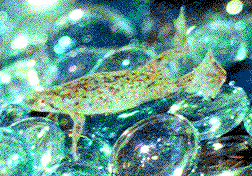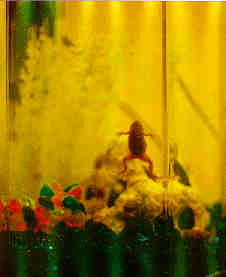Habits: Fairly active, and Yes!!! These guys sing!
- Actually, it sounds more like...hmm..well, it's hard to describe. The first few times
I heard them I thought there was a loose air filter tube in the tank.
Here are a couple of neat recordings of the African Dwarf Frog Song:
-
They are active
little fellows, particularly at night. They swim around a lot, or they like to just float
in a very strange position, which I like to call the "Zen position"
(i.e. arms and legs spread out and often balancing on one foot
as though meditating the deeper meanings of life...) One visitor wrote me recently to tell me that this position actually has a name! It's called "burbling". Occasionally, they float at the top. This is when they are being ULTRA lazy, so they don't have to swim very far when they decide they want to get air. Don't be alarmed if your frogs do this for a couple of hours---it often looks like they are dead but this is not the case. (Just poke them lightly if you're really freaked out, and you'll see that they were just spacing out, not dead!)
If they get very inactive after a water change, be sure that the water doesn't have chlorine! This can be very dangerous for frogs!
Breeding and tadpoles:
-
When the weather gets warm, they get very ...cuddly. The male clasps the back of the female
and hangs on. When the male grabs the female around her midsection, it's called amplecting. The female tends to do a dance like swishing of her flippers at this time.
They can swim around like that for hours. When they actually mate, they swim around in loops in the tank,
so it looks like they are doing circus acts. Once in a blue moon the eggs they lay will hatch...(you can
usually tell that the eggs aren't going to survive if they look cloudy or milky- this means that they have
gotten some air exposure and won't be able to hatch.)
-
Unfortunately, even in the rare occasion that they do hatch, and you manage to save these teeny tiny...(and I really mean tiny) black caviar sized tadpoles into a separate tank... I don't think its likely that they will ever survive long. I tried it a few times, (it gets warm in my home a lot!) and it has never worked for me.
What I've been able to learn, though, is if you want to try to raise the tadpoles, they need to be quickly separated from the tank where their parents are...(the adults tend to mistake the tadpoles for food and by the time they spit them out the little guys are pretty much toast)...into an aerated tank, which,( and I hear this is important) must be kept at 74 degrees F. For feeding at this
tiny size, you can try this powder stuff that can be bought in pet stores (that have fish) that makes the
water a bit cloudy but has protein in it...and if they live long enough, try spiralina fish flakes until they are big enough to eat bloodworms. They are meat eaters, so they should be switched to the bloodworms as soon as possible.
Shedding Skin:
-
Occasionally, they shed their skin. This seems to be related to weather and seasons too, (at least
both my frogs tend to shed within a week of each other) It looks really weird while it is shed because
it gives the illusion that the limbs themselves are coming off...but then when it all comes off they are
happy once again and squeaky clean!
Is my frog dead?
- Generally when the frogs go to Froggy heaven, they don't end up floating at the top the way fish do, but rather they sink.

Click to see full sized. |
If they do float when dead, they usually have some massive bloat, like the dead frog on the right, or some other yucky disease which is really obvious.
The dead frog above on the right died of dropsy. Note: this is NOT a lazy zen pose. Photo courtesy of Alexander Price
I get a lot of frantic mail from nervous Dwarf frog owners concerned about frogs that sit in one place for a really really long time - Having lost several dearly beloved froggies, I can tell you from my own experience that even though I also have wrongly freaked out thinking something was wrong when they were sitting very still, when their time did come, it was REALLY obvious.
Males and females:
- Many have written in asking how to tell males from females. Unfortunately, with the Dwarf frogs it is very very hard to tell.
As a rule, the females tend to be bigger than the males. I have found that the males tend to be darker and rougher looking (as in: "bumpy", not as in: "hey, lets wear leather jackets and go ride motorcycles!"), but this too is a generalization, and often there are exceptions. One visitor writes: the easiest way to tell is to look just posterior to the forelimb. Males have a very distinct white bump there. Some females also have a white patch there, but in males, the bump is very very distinct.
Ive also heard my male frogs make a low humming noise as a mating call. (but I'm not sure if the females dont sometimes sing too..it's hard to tell!)
I understand that during the breeding season (which in an aquarium is hard to determine sometimes, as their climate is so carefully controlled!) the males get darker or slightly enlarged inner arms...but how anyone can tell on so tiny a creature is beyond me! In addition, the females seem to have a teeny tiny tip on their, er...bottom - a bit like a tiny tail, or bump.
I haven't been able to tell what my smallest froggies are yet...it may be a while before they are big enough to distinguish at all! It seems to me that the easiest way to tell, and this is what tipped me off to the fact that Jake was a SHE, was to wait till it gets warm enough for, er, snuggling season. The one that clamps onto the other and piggyback rides is the male.
Lifespan:
- How long do these critters live? Well, I'm not exactly sure. The longest living frog in my collection lived between 1996 - 2002. However, they CAN live MUCH much longer! Their cousins, the Clawed Frogs, have been known to live for as long as 30 years! A friend of mine reported that his dwarf frog lived for 18 years.
|
|
 The shot on the right is a shot of Elwood II.
The shot on the right is a shot of Elwood II.  I have several African dwarf frogs {Hymenochirus
boettgeri}.
I have several African dwarf frogs {Hymenochirus
boettgeri}.
